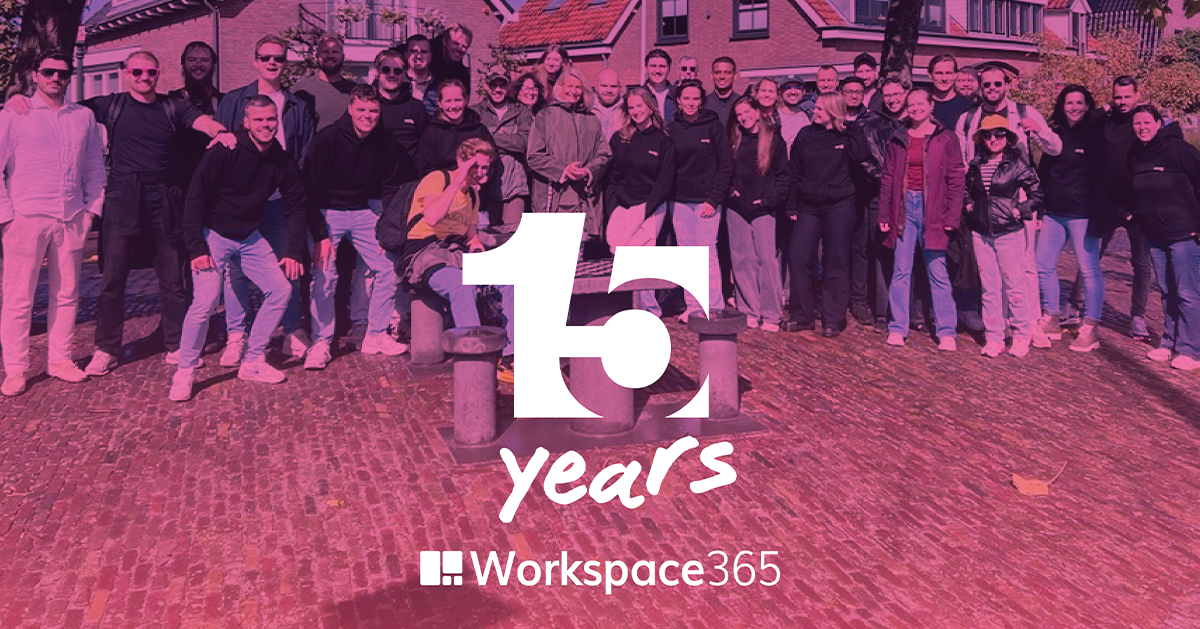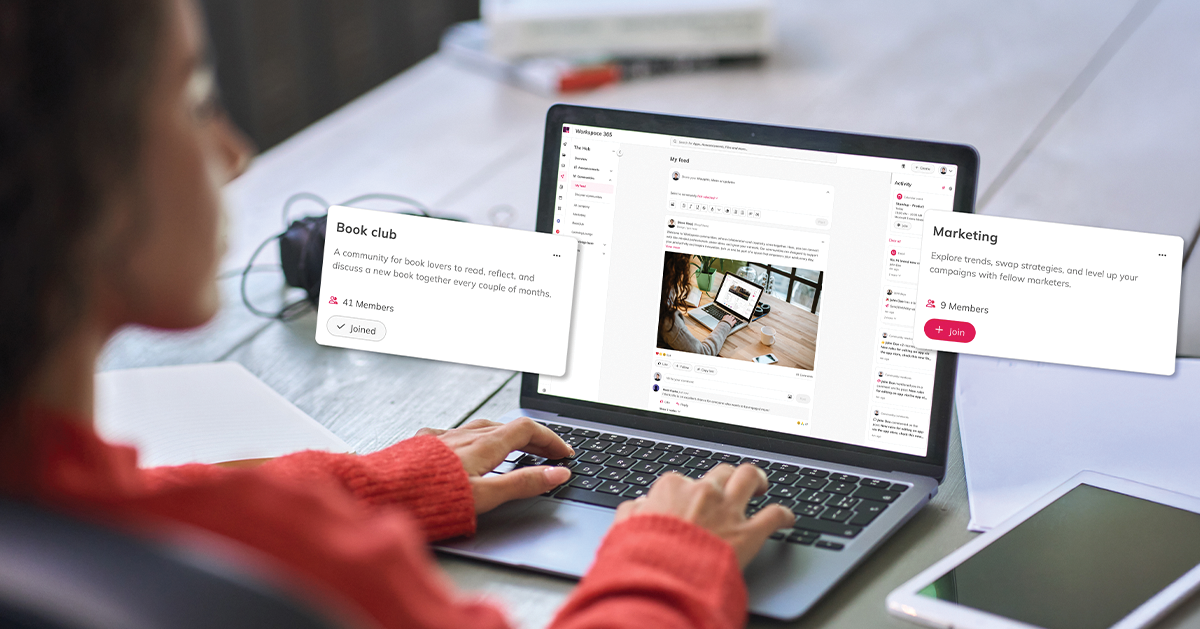When people think of the concept of the digital workspace, most immediately think of a portal where all applications are offered via a single click. Although such a Single Sign-On portal already offers great advantages, it may not be enough for your organisation to achieve maximum productivity and optimal work enjoyment.
A complete digital workspace such as Workspace 365 goes a few steps further. Applications, information, documents, the intranet, processes and tasks are brought together and offered in a personalised manner. In addition, tasks and information can be retrieved from external systems and opened, viewed or executed within the same workspace environment.
Application portal: generally inadequate
A current hot item in many organisations is: bringing together the entire – and usually rapidly growing – application landscape in one place. If this portal is in place, then many organisations think they are done. Sure, undeniably it is a good foundation. But it’s not enough for most companies to fully exploit the potential of a digital workspace.
After all: do you have one page that gets longer and longer because new tiles for applications and (news) messages are added all the time? Then users are also spending more and more time searching for and switching between applications and data. And that is going to get expensive.
Intensive users are found to be switching up to 1100 times per day, that quickly accumulates to costing them half an hour. Not only does this reduce productivity, it can also result in messages being missed and a lot of user frustration.
From static to adaptive and dynamic
Where a ‘bare’ Single Sign-On portal is static, a complete digital workspace such as Workspace 365 is adaptive and dynamic. This is based on three pillars. Firstly, in addition to applications, all data, documents, processes, tasks and the intranet are combined and offered in a personalised manner within one environment.
The second pillar? That is to extract important tasks, information and processes for both individuals and groups of users from external systems and to offer them intelligently in a way and at a time when they are relevant. The user can consult or execute the information, tasks and processes directly from the same dashboard.
The last pillar is personalisation. What exactly is shown on the dashboard depends on someone’s role, location, network and device, among other things. With Workspace 365, you can use an identity service provider such as Microsoft Azure to optimise the workspace for different user groups: with shared spaces you can divide information into clearly defined areas. By allowing admins to create Shared Spaces with shared tile groups, they bring more structure to the workspace – both for themselves and for others.
We zoom in on some of the key features of Workspace 365 that make these pillars possible.
What about your work processes?
In a Single Sign-On portal you conveniently bring your applications together, but what about your processes and information?
Micro Apps are, as it were, small applications within the digital workspace. They bring specific information or tasks from an external application to the dashboard, where the user can work on a task or view the information. Examples include protocols, schedules, support tickets, patient records or leave requests. Because people can quickly find and process information and tasks from different systems, they spend less time switching between applications.
A good example is the Workspace 365 Calendar app. In practice, people often use different applications to see what they need to do today, such as Exchange or an electronic patient record. With our Micro App, users can see all their tasks for the day at a glance and without clicking through.
For many tasks, Micro Apps and connections to external systems are already available as standard. If that is not the case then we can still quickly connect to other applications, provided they have an API.
Display notifications and tasks efficiently
Within Activity feed you can integrate the most important tasks and notifications. Thereby, employees are able to process information and perform tasks much more efficiently, without having to leave the digital workspace. For example, someone from Finance can open an expense report from the feed and immediately accept or delete it.
You can even create your own actions with systems like Zapier and Microsoft Power Automate. These are not just ‘if this then that’ actions, but you can also add actions such as approve, reject, check, add and edit.
Application portal for legacy systems
It should be clear by now: Workspace 365 is not just an application portal but a complete digital workspace. It can not only integrate cloud or web applications into one environment, but also legacy systems and remote desktops that are currently difficult or impossible to modernise.
Whether it is web-based, hosted, local or on-premise applications, you can bring it all together in one place. In doing so you can retain legacy software (whether or not business-critical) and continue its optimal use until you can modernise it.
A portal for everyone?
The versatility and flexibility offered by Workspace 365 also allow for purposes other than the standard usage. For example, we have customers who use the workspace as an extranet. In other words, an intranet for external users. On this portal, you as a company can offer information for and cooperate with external partners.
Another special function that we have realised for customers: Workspace 365 in kiosk mode. Here, people who do not have an IT-intensive job, such as shop assistants or paramedics, only see a few applications and/or relatively little information for a few specific tasks in their digital workspace. The kiosk mode is not focused on completeness but on speed: it primarily ensures that these employees can see what they need at lightning speed.
Simple workspace management
A fully digital workspace offers enormous advantages from the perspective of productivity and work enjoyment, but it must not, of course, become an IT headache. Fortunately, with Workspace 365 workspace management is simple. For example, you can relatively easily create a role-based and condition-based workspace. Users can request applications for their own workstation, which you, as an administrator, can quickly and simply approve or reject.
It is also possible to connect (Azure) Active Directory to Workspace 365 to keep all user management within one central tool. Finally, you can use Conditional Access to easily set conditions for accessing applications in the digital workspace.
The advantages of a fully digital workspace
Compared to ‘just’ an application portal, a fully digital workspace leads to obvious benefits such as increased productivity, improved employee wellbeing and a better employee experience. Other, less obvious benefits include:
- Maximising the value of Microsoft 365. Microsoft is so expansive that many users are dazzled by it – with Workspace 365, they can access all the functionality relevant to them quickly and easily.
- Drive adoption of key tools. Workspace 365 drives adoption of new tools by making it much easier to find, access, and work with them through integration within the digital workspace.
- Boost your digital transformation. A fully digital workspace can boost your digital transformation, in part because new tools can count on wider user adoption.
- Getting more out of your intranet. You can easily integrate your existing intranet (or parts of it) into Workspace 365 (and vice versa). You can even use the digital workspace as an application within Microsoft Teams.
- Optimise the digital employee experience. By implementing a fully digital workspace, employees experience less frustration and can work more efficiently.
- Simplify document management. Employees often find document management tools like SharePoint and OneDrive complicated, while Workspace 365 looks like the file manager they know.
How employees reap the benefits
So far, we have mainly focused on the organisation’s perspective, but let’s look at the entire digital workspace through the employee’s eyes. As Deloitte explains, employees derive job satisfaction from being able to solve problems more effectively through smoother collaborations, from being able to make better decisions through effective and fast communication, and from both peer relationships and a lively company culture created by tools for connecting with colleagues in other departments or branches.
With separate tools, you can achieve all these points. But with these tools, it’s like with your people: you need to connect and bring them together in one – digital or otherwise – environment to create synergy. A fully digital workspace such as Workspace 365 not only brings all applications together in one environment, but it also highlights key information, simplifies actions to a single click, and makes the cluttered clear. In other words, it makes one plus one count for three.







